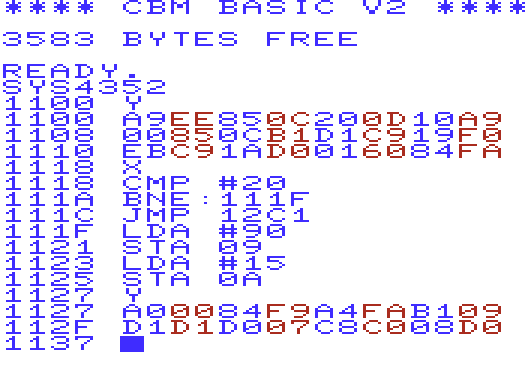There are several (good!) PDF scans of the magazine to be found on archive.org, and I set out to type in EX.MON, published in the 09/1982 issue, on pages 356, 357 and 358:

The tool features a memory hex dump editor and a direct assembler and disassembler, loads into the unexpanded VIC-20 (use LOAD "...",8,1) and it is 1.5 KB in size (download).
- Start with SYS 4352
- Enter 4 digit hex number (without $) to either disassemble a line or dump 8 bytes in hex
- Changes are applied by overtyping disassembly or hex dump and entering line with RETURN
- Address prompt auto-increments
- X command switches to assembly mode
- Y command switches to hex dump mode
- Z command quits EX.MON and returns to BASIC
- (Address) operands generally omit "$"
- Branch target addresses are prefixed with ":"
- Address mode (ZP,X) uses non-standard syntax "(ZP),X" as operand
- LDX ZP,Y and STX ZP,Y use non-standard syntax "ZP,X" as operand
- LDX ABS,Y uses non-standard syntax "ABS,X" as operand (could be fixed by swapping $147E/$147F)
- CLD is not accepted (use "CDL" instead - could be fixed by swapping $15E7/$15E8)
Greetings,
Michael